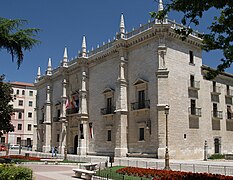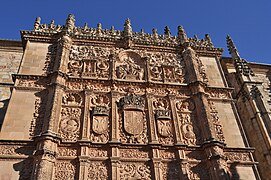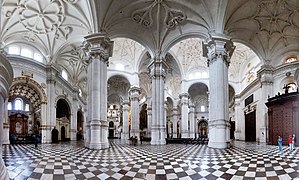Spanish Renaissance architecture
This article relies largely or entirely on a single source. (July 2019) |
Spanish Renaissance architecture was that style of Renaissance architecture in the last decades of the 15th century. Renaissance evolved firstly in Florence and then Rome and other parts of the Italian Peninsula as the result of Renaissance humanism and a revived interest in Classical architecture. In Spain, the Renaissance began to be grafted to Gothic forms as mathematicians and engineers rediscovered building as one of the technological sciences.[1] In the time of King Felipe II (1556–1589), the Renaissance influence expanded throughout the territory thanks to the dissemination of architectural treatises (Vitrubio, Alberti, Serlio, Palladio, Vignola and Sagredo, among others).[2]
In the Hispanic expression of the Renaissance, Italian forms merged with the reminiscences of other previous native styles.
-
The late-15th century Palacio de Santa Cruz, an early example of Renaissance architecture in Valladolid
-
Plateresque facade of the University of Salamanca
-
Dome of the Chapel of El Salvador in Úbeda
As decades passed, the Gothic influence disappeared and the research of an orthodox classicism reached high levels. Although Plateresco is a commonly used term to define most of the architectural production of the late 15th and first half of 16th century, some architects acquired a more sober personal style, like
-
Courtyard of the Palace of Charles V in Granada
-
Panorama of the inside of thecathedral of Granada
From the mid 16th century, under such architects as
List of notable structures

- El Escorial (by Juan Bautista de Toledo and Juan de Herrera)
- University of Salamanca (unknown architect)
- New Cathedral of Salamanca(by Juan de Álava and others)
- Palace of Monterrey in Salamanca (by Rodrigo Gil de Hontañón)
- Diego de Siloé, Juan de Álava and R. G. de Hontañón)
- Convent of San Estebanin Salamanca, (by Juan de Álava and R. G. de Hontañón)
- Palace of Guzmanes in León (by R. G. de Hontañón)
- Hospital de la Santa Cruz in Toledo (by Enrique Egas and Alonso de Covarrubias)
- Hospital de Tavera, in Toledo (by Bartolomé Bustamante)
- Hospital Real, in Granada(by Enrique Egas)
- Palace of Charles V in Granada (by Pedro Machuca)
- Cathedral of Granada (by Juan Gil de Hontañón, Enrigue Egas and Diego de Siloé)
- Jaén Cathedral (by Andrés de Vandelvira)
- Cathedral of Baeza (by Vandelvira)
- Vázquez de Molina Square in Úbeda (by Vandelvira)
- Town Hall in Seville (by Diego de Riaño)
- University of Alcalá de Henares(by Rodrigo Gil de Hontañón and others)
- Royal Collegiate Church of Santa María la Mayor in Antequera, Andalusia (by Pedro del Campo)
- Hostal de los Reyes Católicos of Santiago de Compostela (by Enrique Egas)
- Town Hall of Tarazona
See also
References
- ^ ISBN 0-300-04991-9.
- ^ ISBN 978-3-319-57936-8.
- ^ El Escorial Monastery - History of El Escorial accessed 23 October 2006





![El Escorial, completed in 1584, by Juan Bautista de Toledo and Juan de Herrera[3]](http://upload.wikimedia.org/wikipedia/commons/thumb/f/f3/El_escorial_blick_von_oben.jpg/317px-El_escorial_blick_von_oben.jpg)

